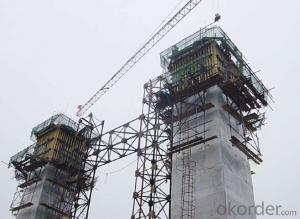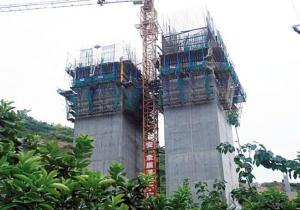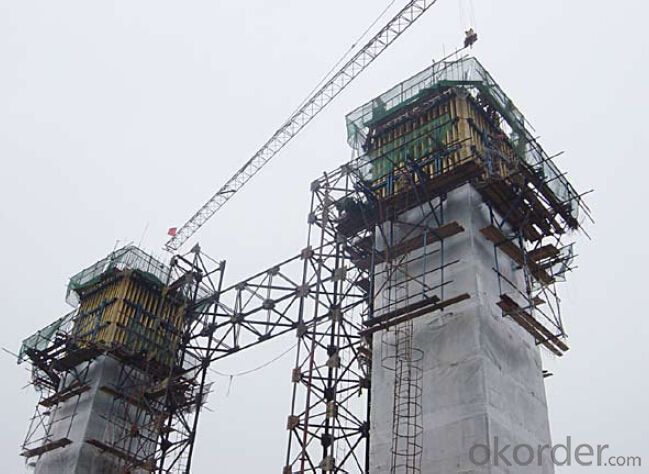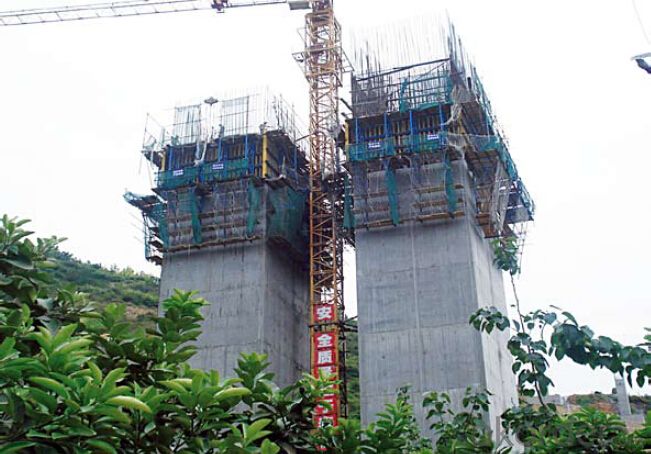Climbing Bracket for Formwork And Scaffolding System
- Loading Port:
- Tianjin
- Payment Terms:
- TT OR LC
- Min Order Qty:
- 50 m²
- Supply Capability:
- 1000 m²/month
OKorder Service Pledge
OKorder Financial Service
You Might Also Like
Climbing Bracket CB240 & CB210
They are framework brackets for supporting large-area wall formwork.
Typical applications for the CB240&CB210 are pier and column/shear wall/core walll/ in the
building.
CB210 has smaller size than CB240, it will be cost effective in some condition.
Characteristics:
◆ High bearing capacity
The high loading capacity of the brackets allow very large scaffold units. This saves the number
anchor points required as well as reducing climbing times.
◆ Simple moving procedure by crane
Through the strong connection of formwork together with the climbing scaffold, both can be moved
as a single climbing unit by crane. Thus valuable time-savings can be achieved.
◆ Fast striking process without a crane
With the retrusive set, large formwork elements can also be retracted quickly and a minimum of
effort.
◆ Safe with work platform
The platforms have assembled firmly with bracket and will be climbing together, without scaffolding
but can work safely in spite of your high location.
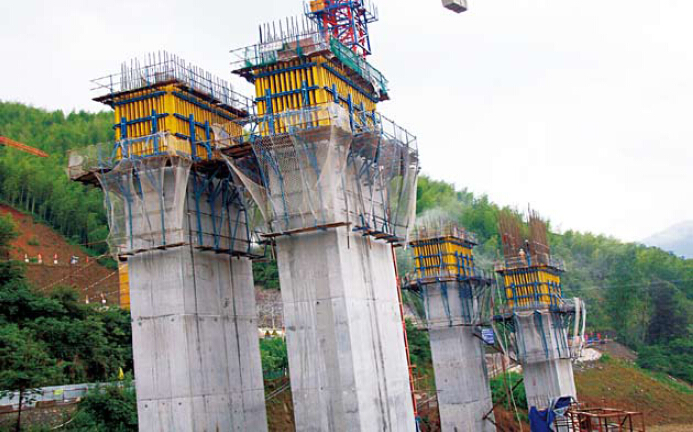
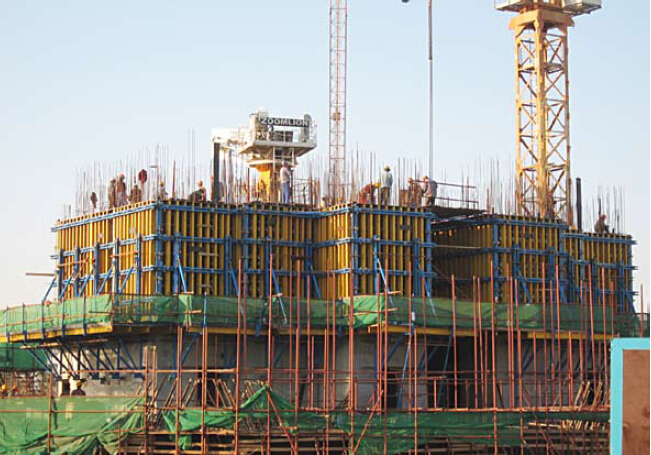
- Q: How does steel formwork contribute to the overall cost of concrete construction?
- Steel formwork can significantly contribute to the overall cost of concrete construction due to its initial higher cost compared to other formwork materials such as wood or plastic. However, it offers various advantages such as durability, reusability, and the ability to withstand higher loads, resulting in reduced labor and material costs in the long run. Moreover, steel formwork provides better quality finishes, faster construction time, and improved safety on-site, which can lead to overall cost savings and enhanced project efficiency.
- Q: Can steel formwork be used for both new construction and renovation projects?
- Yes, steel formwork can be used for both new construction and renovation projects. Steel formwork is highly versatile and can be easily adapted to fit various project requirements. It provides excellent strength and durability, making it suitable for both small and large-scale projects. Steel formwork can be used for constructing new structures as well as for renovating existing ones. It offers the advantage of being reusable, reducing costs and waste in the long run. Additionally, steel formwork allows for precise and accurate construction, ensuring high-quality results in both new construction and renovation projects.
- Q: What are the common safety guidelines when working with steel formwork in hazardous areas?
- To ensure the protection of workers and prevent accidents, certain safety guidelines must be adhered to when working with steel formwork in hazardous areas. Here are some commonly recommended safety guidelines: 1. Personal Protective Equipment (PPE): Workers must wear appropriate PPE, such as safety goggles, gloves, steel-toed boots, and hard hats, to safeguard themselves from potential hazards. 2. Training and Education: Adequate training on working with steel formwork and awareness of the specific hazards in the hazardous areas are essential. This includes understanding safe handling practices and emergency procedures. 3. Hazard Identification and Risk Assessment: Thoroughly assess the hazardous areas before starting work to identify potential risks and hazards. This will facilitate the implementation of suitable safety measures and controls. 4. Fall Protection: Proper fall protection measures should be in place when working at heights, including guardrails, safety harnesses, and safety nets. Workers should be trained on the correct use of fall protection equipment and systems. 5. Fire Safety: In hazardous areas, there is an increased risk of fire. Ensure the availability of fire extinguishers, train workers in their use, and have emergency evacuation plans in place. 6. Electrical Safety: Ensure proper grounding of electrical equipment or tools near the steel formwork and regularly inspect them for safety. Workers should exercise caution and avoid contact with live wires. 7. Proper Handling and Storage: Proper handling and storage of steel formwork materials are crucial to prevent injuries. This includes using appropriate lifting equipment, securely fastening the formwork, and storing it in designated areas to avoid tripping hazards. 8. Adequate Ventilation: If working in confined spaces, ensure proper ventilation to prevent the accumulation of toxic gases or fumes. Workers should be trained to recognize signs and symptoms of exposure to hazardous substances. 9. Regular Inspections and Maintenance: Regularly inspect the steel formwork and surrounding areas to identify any potential safety hazards. Promptly carry out any necessary repairs or maintenance. 10. Communication and Emergency Procedures: Establish clear communication between workers, supervisors, and other stakeholders to ensure awareness of potential hazards and emergency procedures. Regular safety meetings and drills can strengthen this communication. By adhering to these common safety guidelines, workers can minimize the risks associated with working with steel formwork in hazardous areas and create a safer working environment.
- Q: How does steel formwork impact the overall construction productivity?
- Steel formwork has a significant impact on overall construction productivity due to its numerous advantages over other types of formwork systems. Firstly, steel formwork is highly durable and can withstand multiple uses, making it a cost-effective option for construction projects. Unlike traditional timber formwork, steel formwork does not warp or shrink, ensuring consistent dimensions and reducing the need for frequent repairs or replacements. This durability saves time and money by eliminating the delay caused by formwork maintenance or replacement. Additionally, steel formwork offers superior strength and stability, allowing for the construction of larger and more complex structures. The rigid and sturdy nature of steel formwork ensures that it can support heavy concrete loads without any deformation or collapse. This strength and stability not only enhance the safety of the construction site but also facilitate the construction process by enabling faster pouring of concrete and reducing the need for additional support structures. Moreover, steel formwork is highly versatile and can be easily customized to meet specific project requirements. It can be easily assembled, disassembled, and repositioned, allowing for efficient use in various construction phases. This flexibility saves time and effort as it eliminates the need for constantly constructing new formwork for different parts of the structure. The ability to reuse steel formwork also reduces material waste, further contributing to improved productivity. Furthermore, steel formwork offers better surface finishes compared to other formwork systems. Its smooth and rigid surface ensures that the concrete achieves a high-quality finish, reducing the need for additional finishing work such as plastering or leveling. This results in time savings and improved overall construction productivity. In conclusion, steel formwork positively impacts overall construction productivity by providing durability, strength, stability, versatility, and high-quality finishes. Its long-lasting nature, ease of use, and ability to withstand heavy concrete loads contribute to reduced downtime and increased efficiency on construction sites. With these advantages, steel formwork proves to be an essential component in enhancing construction productivity.
- Q: How does steel formwork handle different concrete reinforcement types?
- Steel formwork is an excellent choice for dealing with various types of concrete reinforcement due to its versatility and durability. It is commonly used in construction projects to create temporary molds or structures that hold concrete in place during the pouring and curing process. One of the benefits of steel formwork is its ability to handle different types of concrete reinforcement. Whether it's traditional reinforcement like steel bars or modern techniques such as fiber-reinforced polymers (FRP), steel formwork can accommodate them all. Steel formwork is specifically designed to be strong and rigid, enabling it to support the weight and pressure exerted by different reinforcement materials. It can withstand the forces exerted by steel bars or the tensile strength of FRP without experiencing any deformations or collapsing. Furthermore, steel formwork is highly adaptable and can be easily adjusted or modified to suit different reinforcement types. It can be cut or welded to create openings or recesses for steel bars or other materials to pass through. This flexibility guarantees that steel formwork can be tailored to meet the specific requirements of each construction project. Moreover, steel formwork provides a smooth and even surface finish, which is crucial for ensuring proper adhesion between the concrete and the reinforcement materials. This ensures that the reinforcement is securely embedded within the concrete structure, offering the necessary structural integrity and strength. To conclude, steel formwork is a dependable and efficient solution for managing different types of concrete reinforcement. Its strength, adaptability, and ability to provide a smooth surface finish make it an ideal choice for construction projects that necessitate diverse reinforcement materials.
- Q: Can steel formwork be used for hospital construction projects?
- Yes, steel formwork can be used for hospital construction projects. Steel formwork is a versatile and durable construction material that offers several advantages for hospital projects. It provides excellent strength and stability, which is crucial for ensuring the safety and integrity of the building. Steel formwork also allows for efficient and precise construction, as it can be easily assembled and disassembled, and its modular nature allows for flexibility in design and layout changes. Additionally, steel formwork has a smooth surface finish, which is important for maintaining a hygienic environment in a hospital setting. It is also resistant to moisture and chemicals, making it suitable for areas that require frequent cleaning and sterilization. Overall, steel formwork is a reliable and suitable choice for hospital construction projects.
- Q: Can steel formwork be used for industrial structures?
- Yes, steel formwork can be used for industrial structures. Steel formwork refers to the use of steel panels or sheets to create temporary molds or frameworks that hold and shape concrete during the construction process. Steel formwork is preferred for industrial structures due to its strength, durability, and ability to withstand heavy loads and high pressures. Industrial structures often require robust formwork systems that can handle the weight of large concrete pours and provide sufficient support during the curing process. Steel formwork offers these characteristics, making it an ideal choice for industrial construction projects. Additionally, steel formwork provides excellent dimensional accuracy, ensuring precise and consistent results in the construction of industrial structures. It can be easily adjusted and reused, which leads to cost savings and increased efficiency in the construction process. Another advantage of steel formwork is its ability to withstand harsh weather conditions and extreme temperatures, making it suitable for various industrial settings. It is resistant to warping, cracking, and other forms of damage, ensuring the integrity and longevity of the structure. Furthermore, steel formwork can be customized to meet the specific requirements of different industrial structures, allowing for flexibility in design and construction. It can be easily assembled and disassembled, enabling faster construction cycles and reducing overall project timelines. Overall, steel formwork is a highly suitable choice for industrial structures due to its strength, durability, dimensional accuracy, weather resistance, and flexibility. It offers numerous advantages over other formwork materials, making it a preferred option in the construction industry.
- Q: Are there any specialized tools or equipment required for steel formwork?
- Specialized tools and equipment are necessary for steel formwork. Some commonly used tools are as follows: 1. To secure the steel formwork panels together and maintain stability and alignment, formwork clamps are utilized. 2. Formwork ties are employed to hold the formwork panels in place and prevent any movement while concrete is being poured and cured. 3. Formwork brackets are utilized to evenly distribute the load and provide support to the formwork panels. 4. Formwork shuttering magnets are utilized to securely hold the formwork panels in place, establishing a strong connection. 5. Formwork jacks are utilized to adjust the height of the formwork panels, enabling precise leveling and alignment. 6. Formwork hangers are employed to suspend the formwork panels from overhead structures, enhancing stability and support. 7. Formwork props are utilized to vertically support the formwork panels, ensuring their position during the concrete pouring process. 8. Formwork vibrators are used to eliminate air bubbles and guarantee proper compaction of the concrete within the formwork. Proper and appropriate use of these specialized tools and equipment is crucial to maintain the structural integrity and quality of the steel formwork.
- Q: Can steel formwork be easily transported to different construction sites?
- Steel formwork can be conveniently transported to different construction sites. It is renowned for its robustness and resilience, enabling it to withstand transportation without suffering any notable harm. Moreover, steel formwork can be effortlessly disassembled and reassembled, rendering it highly portable. This characteristic empowers construction companies to reuse the formwork at multiple locations, minimizing the necessity for fresh materials and resulting in cost savings. The adaptability and ease of transportation of steel formwork make it a favored option among contractors for diverse construction endeavors.
- Q: What is the weight of steel formwork?
- The weight of steel formwork can vary depending on its size and thickness. However, on average, steel formwork typically weighs around 20 to 25 kilograms per square meter.
Send your message to us
Climbing Bracket for Formwork And Scaffolding System
- Loading Port:
- Tianjin
- Payment Terms:
- TT OR LC
- Min Order Qty:
- 50 m²
- Supply Capability:
- 1000 m²/month
OKorder Service Pledge
OKorder Financial Service
Similar products
Hot products
Hot Searches
